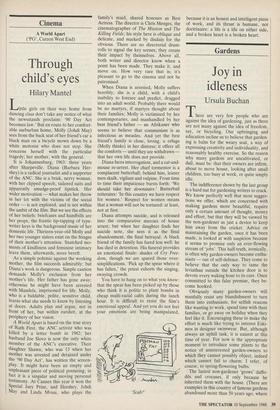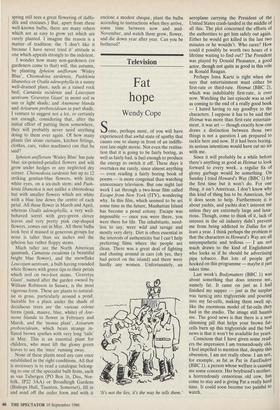Gardens
Joy in idleness
Ursula Buchan
There are very few people who are against the idea of gardening, just as there are not many against the idea of freedom, say, or bicycling. Our upbringing and education incline us to believe that garden- ing is balm for the weary soul, a way of expressing creativity and individuality, and reasonably healthy exercise. So the reason why many gardens are uncultivated, or dull, must be: that their owners are infirm, about to move house, looking after small children, too busy at work, or quite simply idle.
The indifference shown by the last group is a hard nut for gardening writers to crack. We know perfectly well that most sugges- tions we offer, which are concerned with making gardens more beautiful, require only a certain amount of thought, money and effort, but that they will be viewed by the non-gardener as just a device to keep him away from the cricket. Advice on maintaining the garden, once it has been made, is looked at with suspicion because it seems to promise only an ever-flowing stream of 'jobs'. This half-truth, ironically, is often why garden-owners become enthu- siasts — out of self-defence. They come to believe that the only way to tame the leviathan outside the kitchen door is to devote every waking hour to its care. Once committed to this false premise, they be- come hooked. .
Obvipusly many garden-owners will manfully resist any blandishment to turn them into enthusiasts, for selfish reasons like wanting to work, spend time with their families, or go away on holiday when they feel like it. Encouraging these to make the effort is much like trying to interest Eski- mos in designer swimwear. But, although always an uphill task, it is easiest at this time of year. For now is the appropriate moment to introduce some plants to the notice of uninterested garden-owners to which they cannot possibly object, indeed which cannot fail to charm. I refer, of course, to spring-flowering bulbs.
The laziest non-gardener 'grows' daffo- dils and crocuses, if only because he inherited them with the house. (There are examples in this country of famous gardens abandoned more than 50 years ago, where spring still sees a great flowering of daffo- dils and crocuses.) But, apart from these well-known bulbs, there are many others which are as easy to grow yet which are rarely planted. I imagine the reason is a matter of tradition: the don't like it because I have never tried it' attitude is one which appeals strongly to the indolent.
I wonder how many non-gardeners (or gardeners come to that) will, this autumn, be planting 1pheion uniflorum Wisley Blue', Chionodoxa sardensis, Pushkinia libanotica or Oxalis adenophylla in a sunny well-drained place, such as a raised rock bed; Camassia esculenta and Leucojum aestivum `Gravetye Giant' in moist soil in sun or light shade; and Anemone blanda and Arisarum proboscideum in part shade. I venture to suggest not a lot, or certainly not enough, considering that, after the initial effort of putting them somewhere, they will probably never need anything doing to them ever again. Of how many plants (let alone curtains, kitchen fittings, clothes, cars, video machines) can that be said?
Ipheion uniflorum Wisley Blue' has pale blue six-pointed-petalled flowers and will grow under hedges or any neglected dry corner. Chionodoxa sardensis has up to 12 striking gentian-blue flowers, with little white eyes, on a six-inch stem; and Push- kinia libanotica is not unlike a chionodoxa but with smaller flowers which are white with a blue line down the centre of each petal. All these flower in March and April, whereas Oxalis adenophylla, a very well- behaved sorrel with grey-green clover leaves and very pretty pink cup-shaped flowers, comes out in May. All these bulbs look best if massed in generous groups for none is taller than six inches and the ipheion has rather floppy stems.
Much taller are the North American quamash, Camassia esculenta (a beautiful bright blue flower), and the snowflake Leucojum aestivum, a bulb having rounded white flowers with green tips to their petals which nod on two-foot stems. `Gravetye Giant', named after the garden owned by William Robinson in Sussex, is the most vigorous form. These are plants to natural- ise in grass, particularly around a pond. Suitable for a place under the shade of deciduous trees are the various colour forms (pink, mauve, blue, white) of Ane- mone blanda to flower in February and March, and the 'mouse plant', Arisarum proboscideum, which bears strange in- flated brown spathes with very long 'tails' in May. This is an essential plant for children, who must lift the glossy green leaves to see the 'mice' running away.
None of these plants need any care once established in the right conditions. All that is necessary is to read a catalogue belong- ing to one of the specialist bulb firms, such as van Tubergen (PO Box 16, Diss, Nor- folk, IP22 3AA) or Broadleigh Gardens (Bishops Hull, Taunton, Somerset), fill in and send off the order form and with it enclose a modest cheque, plant the bulbs according to instructions when they arrive, some time between now and mid- November, and watch them grow, flower, and die down year after year. Can you be bothered?























































 Previous page
Previous page